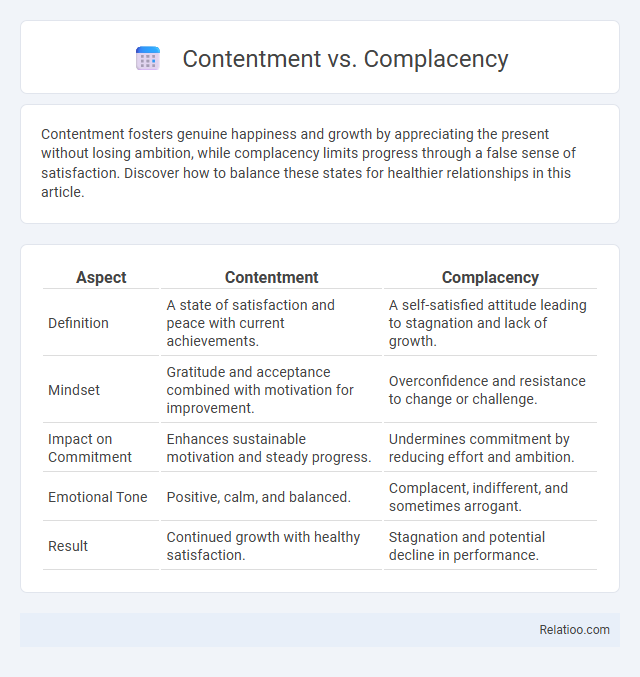Contentment fosters genuine happiness and growth by appreciating the present without losing ambition, while complacency limits progress through a false sense of satisfaction. Discover how to balance these states for healthier relationships in this article.
Table of Comparison
| Aspect | Contentment | Complacency |
|---|---|---|
| Definition | A state of satisfaction and peace with current achievements. | A self-satisfied attitude leading to stagnation and lack of growth. |
| Mindset | Gratitude and acceptance combined with motivation for improvement. | Overconfidence and resistance to change or challenge. |
| Impact on Commitment | Enhances sustainable motivation and steady progress. | Undermines commitment by reducing effort and ambition. |
| Emotional Tone | Positive, calm, and balanced. | Complacent, indifferent, and sometimes arrogant. |
| Result | Continued growth with healthy satisfaction. | Stagnation and potential decline in performance. |
Understanding Contentment: The Power of Inner Peace
Contentment represents a deep sense of inner peace and satisfaction with one's current circumstances, fostering emotional stability and mental well-being. Unlike complacency, which implies stagnation and a lack of motivation for growth, contentment encourages acceptance without sacrificing personal development. Recognizing the power of inner peace through contentment helps individuals cultivate resilience, gratitude, and a balanced perspective on life's challenges.
Defining Complacency: The Hidden Risks
Complacency is characterized by a false sense of security where you overlook potential dangers or opportunities, leading to stagnation and vulnerability. Unlike contentment, which involves a healthy satisfaction with your current state and motivates growth, complacency breeds negligence and prevents progress. Recognizing complacency's hidden risks is crucial to maintaining vigilance and fostering continuous improvement in your personal and professional life.
Contentment vs Complacency: Key Differences
Contentment is a positive state of satisfaction and inner peace, encouraging personal growth and gratitude, while complacency reflects a stagnation that hinders progress due to self-satisfaction with current achievements. You can recognize contentment by its motivation to improve and embrace challenges, whereas complacency often leads to neglecting opportunities and settling for less. Understanding these key differences helps you maintain a healthy balance between appreciating your success and striving for continuous development.
Why Contentment Fuels Growth
Contentment fuels growth by fostering a positive mindset that embraces gratitude and motivates continuous self-improvement rather than settling for mediocrity. Unlike complacency, which breeds stagnation and resistance to change, contentment encourages recognizing achievements while remaining open to new challenges and opportunities. This balanced state promotes resilience and personal development, driving progress in both personal and professional life.
How Complacency Hinders Success
Complacency stifles success by fostering a false sense of achievement that discourages growth and improvement, leading individuals to overlook potential risks and opportunities for advancement. Unlike contentment, which promotes a healthy satisfaction and motivation to maintain progress, complacency breeds stagnation and reduces the drive necessary to overcome challenges. Understanding these distinctions is crucial for maintaining a proactive mindset that fuels continuous personal and professional development.
Signs You Are Content, Not Complacent
Signs you are content, not complacent, include a consistent sense of inner peace and gratitude for what you have while still maintaining motivation to grow and improve. Contentment involves appreciating present achievements without settling for mediocrity or avoiding challenges. Key indicators include setting meaningful goals, embracing change proactively, and cultivating resilience without succumbing to stagnation or apathy.
Factors Leading to Complacency in Life
Complacency in life often arises from comfort zones, lack of challenges, and an overstated sense of achievement, leading to stagnation and missed growth opportunities. Unlike contentment, which fosters a healthy satisfaction paired with continuous improvement, complacency breeds apathy and resistance to change, undermining personal and professional progress. Your awareness of these factors is crucial to avoid complacency and maintain motivated, purposeful living.
Cultivating Healthy Contentment
Cultivating healthy contentment involves recognizing satisfaction with current achievements while maintaining motivation for growth, distinguishing it from complacency, which implies stagnation and lack of ambition. Contentment encourages gratitude and mindfulness, fostering emotional well-being without diminishing the drive for personal or professional development. Emphasizing balance in contentment supports resilience and long-term fulfillment, avoiding the pitfalls of complacency that hinder progress.
Overcoming Complacency with Self-Awareness
Overcoming complacency requires cultivating self-awareness to recognize when comfort zones hinder Your growth and potential. Contentment fosters a balanced state of satisfaction without stagnation, while complacency breeds inactivity due to false security. Developing mindfulness and setting purposeful goals empower You to maintain progress and avoid the pitfalls of complacency.
Achieving Balance: Striving Without Stress
Achieving balance between contentment, complacency, and ambition involves recognizing when to appreciate your current state without losing the drive for growth. You can cultivate contentment by valuing progress and gratitude while avoiding complacency that halts growth and innovation. Striving without stress requires setting realistic goals and maintaining mindfulness to ensure ambition fuels motivation rather than anxiety.

Infographic: Contentment vs Complacency
 relatioo.com
relatioo.com